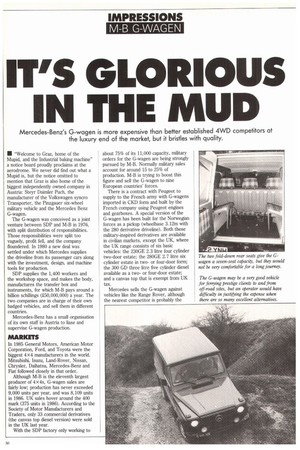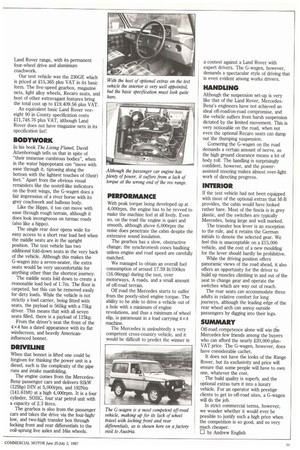IT'S GLORIOUS IN THE MUD
Page 32

Page 33

If you've noticed an error in this article please click here to report it so we can fix it.
Mercedes-Benz's G-wagen is more expensive than better established 4WD competitors at the luxury end of the market, but it bristles with quality.
• "Welcome to Graz, home of the Mupid, and the Industrial baking machine" a notice board proudly proclaims at the aerodrome. We never did find out what a Mupid is, but the notice omitted to mention that Graz is also home of the biggest independently owned company in Austria: Steyr Daimler Puch, the manufacturer of the Volkswagen syncro Transporter, the Pinzgauer six-wheel military vehicle and the Mercedes Benz G-wagen.
The G-wagen was conceived as a joint venture between SDP and M-B in 1976, with split distribution of responsibilities. Those responsibilities were split too vaguely, profit fell, and the company floundered. In 1980 a new deal was settled under which Mercedes supplies the driveline from its passenger cars along with the investment, design, and machine tools for production.
SDP supplies the 1,400 workers and the workshop space, and makes the body, manufactures the transfer box and instruments, for which M-B pays around a billion schillings (£50,000,000) a year. The two companies are in charge of their own badged vehicles, and sell them in different countries.
Mercedes-Benz has a small organisation of its own staff in Austria to liase and supervise G-wagen production.
MARKETS
In 1985 General Motors, American Motor Corporation, Ford, and Toyota were the biggest 4x4 manufacturers in the world. Mitsubishi, Isuzu, Land-Rover, Nissan, Chrysler, Daihatsu, Mercedes-Benz and Fiat followed closely in that order.
Although M-B is the eleventh largest producer of 4x4s, G-wagen sales are fairly low; production has never exceeded 9,000 units per year, and was 8,109 units in 1986. UK sales hover around the 400 mark (375 units in 1986). According to the Society of Motor Manufacturers and Traders, only 33 commercial derivatives (the canvas top diesel version) were sold in the UK last year.
With the SDP factory only working to about 75% of its 11,000 capacity, military orders for the G-wagen are being strongly pursued by M-B. Normally military sales account for around 15 to 25% of production. M-B is trying to boost this figure and sell the G-wagen to nine European countries forces.
There is a contract with Peugeot to supply to the French army with G-wagens imported in CKD form and built by the French company using Peugeot engines and gearboxes. A special version of the G-wagen has been built for the Norwegian forces as a pickup (wheelbase 3.12m with the 280 derivative driveline). Both these military-inspired derivatives are available in civilian markets, except the UK, where the UK range consists of six basic vehicles: the 230GE 2.3 litre four cylinder two-door estate; the 280GE 2.7 litre six cylinder estate in twoor four-door form; the 300 GD three litre five cylinder diesel available as a twoor four-door estate; and a canvas top that is exempt from UK tax.
Mercedes sells the G-wagen against vehicles like the Range Rover, although the nearest competitor is probably the Land Rover range, with its permanent four-wheel drive and aluminium coachwork.
Our test vehicle was the 230GE which is priced at E15,365 plus VAT in its basic form. The five-speed gearbox, magazine nets, light alloy wheels, Recaro seats, and host of other extravagant features bring the total cost up to £19,409.56 plus VAT.
An equivalent basic Land Rover veeeight 90 in County specification costs £11,748.76 plus VAT, although Land Rover does not have magazine nets in its specification list!
BODYWORK
In his book The Living Planet, David Attenborough tells us that in spite of "their immense cumbrous bodies", when in the water hippopotami can "move with ease through it, tiptoeing along the bottom with the lightest touches of (their) feet." Apart from the obvious visual reminders like the nostril-like indicators on the front wings, the G-wagen does a fair impression of a river horse with its grey coachwork and bulbous body.
Like the Hippo, it too can move with ease through rough terrain, although it does look incongruous on tarmac roads (also like a hippo).
The single rear door opens wide for easy access to a short rear load bed when the middle seats are in the upright position. The test vehicle has two additional fold-down seats in the very back of the vehicle. Although this makes the G-wagen into a seven-seater, the extra seats would be very uncomfortable for anything other than the shortest journey.
The middle seats fold down to create a reasonable load bed of 1.7m. The floor is carpeted, but this can be removed easily for dirty loads. While the vehicle is not strictly a load carrier, being fitted with seats, the payload is 565kg with a 75kg driver. This means that with all seven seats filled, there is a payload of 115kg.
From the driver's seat the front of the 4 x4 has a dated appearance with its flat windscreen, and heavily Americaninfluenced bonnet.
DRIYELINE
When that bonnet is lifted one could be forgiven for thinking the power unit is a diesel, such is the complexity of the pipe runs and intake manifolding.
The engine comes from the MercedesBenz passenger cars and delivers 92kW (125hp) DIN at 5,000rpm, and 192Nm (141.61bft) at a high 4,000rpm. It is a four cylinder, SOHC, four star petrol unit with a capacity of 2.3 litres.
The gearbox is also from the passenger cars and takes the drive via the four-high/ low, and two-high transfer box through locking front and rear differentials to the coil-sprung live axles and 16in wheels.
PERFORMANCE
With peak torque being developed up at 4,000rpm, the engine has to be revved to make the machine feel at all lively. Even so, on the road the engine is quiet and smooth, although above 6,000rpm the noise does penetrate the cabin despite the extensive sound insulation.
The gearbox has a slow, obstructive change; the synchromesh cones baulking unless engine and road speed are carefully matched.
We managed to obtain an overall fuel consumption of around 17.59 lit/100km (16.06mpg) during the test, over motorways, A roads, and a small amount of off-road terrain.
Off road the Mercedes starts to suffer from the poorly-sited engine torque. The ability to be able to drive a vehicle out of a hole with a minimum of engine revolutions, and thus a minimum of wheel slip, is paramount in a load carrying 4x4 machine.
The Mercedes is undoubtedly a very competent cross-country vehicle, and it would be difficult to predict the winner in a contest against a Land Rover with expert drivers. The G-wagen, however, demands a spectacular style of driving that is even evident among works drivers.
HANDLING
Although the suspension set-up is very like that of the Land Rover, MercedesBenz's engineers have not achieved an ideal off-road/on-road compromise, and the vehicle suffers from harsh suspension dictated by the limited movement. This is very noticeable on the road, when not even the optional Recaro seats can damp out the thumping suspension.
Cornering the G-wagen on the road demands a certain amount of nerve, as the high ground clearance means a lot of body roll. The handling is surprisingly confident, however, and the powerassisted steering makes almost over-light work of directing progress.
INTERIOR
If the test vehicle had not been equipped with most of the optional extras that M-B provides, the cabin would have looked rather bare. Most of the fascia is in grey plastic, and the switches are typically Mercedes, being large and well marked.
The transfer box lever is an exception to the rule, and it retains the German initials to denote the selected gear. We feel this is unacceptable on a 215,000 vehicle, and the cost of a new moulding for the lever should hardly be prohibitive.
While the driving position offers panoramic views of the road ahead, it also offers an opportunity for the driver to build up muscles climbing in and out of the seat to change gear and operate the switches which are way out of reach.
The rear seats can accommodate three adults in relative comfort for long journeys, although the leading edge of the rear wheel arch can annoy outside passengers by digging into their legs.
SUMMARY
Off-road competence alone will win tile Mercedes few friends among the buyers who can afford the nearly £20,000-plusVAT price. The G-wagen, however, does have considerable cachet.
It does not have the looks of the Range Rover, but its exclusivity and price will ensure that some people will have to own one, whatever the cost.
The build quality is superb, and the optional extras turn it into a luxury vehicle. For an operator with prestige clients to get to off-road sites, a G-wagen will do the job.
In strict commercial terms, however, we wonder whether it would ever be possible to justify such a high price when the competition is so good, and so very much cheaper.
12 by Andrew English




















































































































































